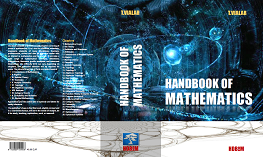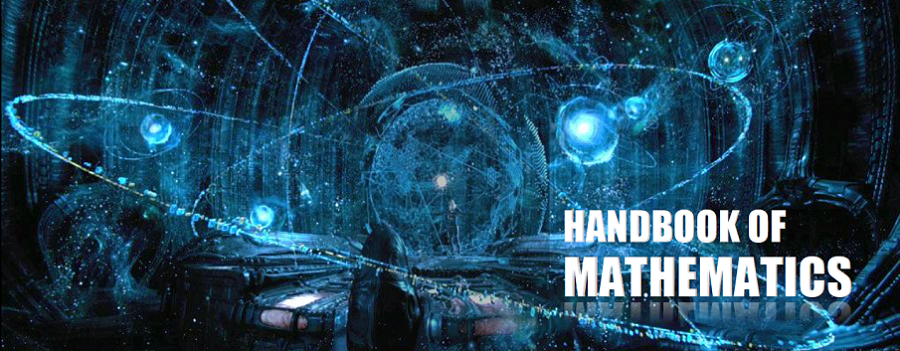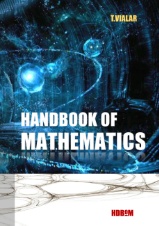Handbook of Mathematics.
Ebook published on May 23, 2017
Hardcover published on April 4, 2017
Softcover published on Dec. 7, 2016
Format: 15.5x22 cm, 1132 pages, revised
ISBN 978-2-9551990-1-5 : Hardcover
ISBN 978-2-9551990-0-8 : Softcover
ISBN 978-2-9551990-2-2 : EBook
Author: Thierry Vialar
Publisher: HDBOM
Refer to HDBOM.COM

book details (version 2016-2017)
HANDBOOK OF
MATHEMATICS
Print version
. Hardcover-Hardback
Published on April 4, 2017
XVIII, 1132 p.
ISBN: 9782955199015
57,90 Euros
. Softcover-Paperback
Published on December 7, 2016
ISBN-13: 978-2-955-19900-8
EAN: 9782955199008
49,99 Euros
eBook version - Kindle
Published on May 23, 2017
ISBN: 9782955199022
39.99 Euros
Thierry Vialar (PhD).
HDBOM.
Language: English
Table of contents: pp i-xviii, 28 p.
Appendices: pp 1033-1051, 18 p.
Index: pp 1054-1110, 56 p.
Illustrations: Thousands illustrations and pictures.
Format: 15.5 x 6 x 22 cm - 6.1 x 2.36 × 8.66 in).
Format: Two-column format. Fontsize 7.5.
Weight (for paperback version): 1.5 kgs, or 3.3 pounds.
Typesetting with LaTeX, Scientific Word (MacKichan software), and AMS pachages, AMSFonts.
Paper: 80 grs.
Google Preview
| National Library of France (General Catalog): |

|
table of contents (level 1)
|
Introduction
Part I. Foundations of Mathematics.
Chap.1. Mathematical Logic.
- Section 1. Propositions, Connections
- Section 2. Propositional and Predicate Calculus
- Section 3. Extension of First-order Predicate Calculus
- Section 4. Formal System
- Section 5. Demonstrations and Definitions
Chap.2. Set Theory.
- Section 1. Basic Concepts
- Section 2. Set Algebra
- Section 3. Lattice Theory
- Section 4. Foundations of Sets
- Section 5. Problems of Set Theory
- Section 6. Zermelo-Fraenkel Set Theory (ZFC)
- Section 7. Banach-Tarski paradox and ZF
- Section 8. Hahn-Banach Theorems
Chap.3. Relations and Structures.
- Section 1. Relations
- Section 2. Maps, Functions
- Section 3. Families
- Section 4. Laws of Composition
- Section 5. Power, Cardinal, Denumerability
- Section 6. Cardinals
- Section 7. Structures
- Section 8. Algebraic Structures
- Section 9. Order Structure
- Section 10. Ordinals
- Section 11. Topological Structures
Chap.4. Arithmetic.
- Section 1. Set of Natural Numbers ℕ
- Section 2. Denumerability (Counting)
- Section 3. Divisibility
- Section 4. Integers ℤ
- Section 5. Rational Numbers ℚ
- Section 6. A General Exercise
Chap.5. Construction of Number System.
- Section 1. Semigroup of Natural Numbers
- Section 2. Ring of Integers
- Section 3. Field of Rational Numbers
- Section 4. Real Numbers
- Section 5. Complex Numbers
- Section 6. Synthesis, Generalization
Part II. Algebra.
Chap.6. Algebra
- Section 1. Introduction
- Section 2. Group Theory
- Section 3. Rings and Fields
- Section 4. Modules, Vector Spaces
- Section 5. Linear Maps and Matrices
- Section 6. Equation and System of Equations
- Section 7. Algebra of Polynomials
- Section 8. Polynomials over ℝ and ℂ
- Section 9. Fractions and Rational Functions
- Section 10. Polynomial Rings
- Section 11. Field Extensions
- Section 12. Prime fields, Finite fields
- Section 13. Galois Theory
- Section 14. Galois Theory Application
- Section 15. Lie Groups
- Section 16. Linear Algebra
- Section 17. Eigenvalue, Eigensubspace
- Section 18. Hermitian Form, Pre-Hilbert Space
- Section 19. Exterior Algebra of Vector Space
Part III. Number Theory.
Chap.7. Number Theory
- Section 1. Divisibility in an integral domain
- Section 2. Diophantine Equations and Residues
- Section 3. Absolute Value, Valuation
- Section 4. Prime Numbers
Part IV. Geometry.
Chap.8. Geometry
- Section 1. Contruction, and Overview
- Section 2. Fundamental Concepts
- Section 3. Absolute geometry
- Section 4. Euclidean and non Euclidean Metrics
- Section 5. Affine and Projective Planes
- Section 6. Collineations and Correlations
- Section 7. Ideal Plane, Coordinates
- Section 8. Projective Metric
- Section 9. Order and Orientation
- Section 10. Angles and Measurements
- Section 11. Rigid Transformations
- Section 12. Similarity in Geometry
- Section 13. Affine Maps
- Section 14. Projective maps
- Section 15. Analytic Representations
- Section 16. Descriptive Geometry
- Section 18. Hyperbolic Geometry
- Section 19. Elliptic Geometry
Part V. Analytic Geometry.
Chap.9. Analytic Geometry
- Section 1. Vector spaces V3
- Section 2. Scalar, Vector and Mixed products
- Section 3. Line and Plane Equations
- Section 4. Sphere and Conics
- Section 5. Displacement, Affine map in R3
- Section 6. Quadrics
- Section 7. Affine Space on Rn
Part VI. Topology.
Chap.10. Topology
- Section 1. Overview
- Section 3. Basic Topological Notions of ℝp
- Section 4. Definition of a Topological Space
- Section 5. Metric Space, Basis, Neighborhood Basis
- Section 6. Topological Map, Topological Subspace
- Section 7. Quotient, Product and Sum Spaces
- Section 8. Connectedness, Arc-connected space
- Section 9. Sequence Convergence and Filter Base
- Section 10. Separation Axioms
- Section 11. Compactness
- Section 12. Metrization
- Section 13. Dimension Theory
- Section 14. Theory of Curves
- Section 15. Completion
Chap.11. Topology II
- Section 1. Introduction
- Section 2. Prerequisites, Reminders
- Section 3. Distances and Metric Spaces
- Section 4. Limits and Cluster Points
- Section 5. Compact and locally compact spaces
- Section 6. Connected spaces
- Section 7. Metric and Semi-metric Spaces
- Section 8. Baire Spaces
- Section 9. Mapping Spaces (or Function Spaces)
- Section 10. Normed Vector Spaces
- Section 11. Hilbert Spaces
Part VII. Algebraic Topology.
Chap.12. Algebraic Topology
- Section 1. Homotopy
- Section 2. Polyhedra
- Section 3. Fundamental Group of a Connected Polyhedron
- Section 4. Surfaces
- Section 5. Homology Theory
- Section 6. Graph Theory
- Section 7. Bundles
Chap.13. Algebraic Topology II
- Section 1. Introduction
- Section 2. Some Topological Notions
- Section 3. Simplexes
- Section 4. The Fundamental Group
- Section 5. Singular Homology
- Section 6. Long Exact Sequences
- Section 7. Excision
- Section 8. Simplicial Complexes
- Section 9. CW Complexes
- Section 10. Natural Transformations
- Section 11. Covering Spaces
- Section 12. Homotopy Groups
- Section 13. Cohomology
|
Part VIII. Analysis.
Chap.14. Real Analysis
- Section 1. Structures on ℝ
- Section 2. Sequences, Series
- Section 3. Real Functions
Chap.15. Differential Calculus
- Section 1. Overview
- Section 2. Functions of Differentiable Real Variable
- Section 3. Mean Value Theorems
- Section 4. Expansion In Series
- Section 5. Rational Functions
- Section 6. Algebraic Functions
- Section 7. Non-algebraic Functions
- Section 8. Approximation Theory
- Section 9. Interpolation Theory
- Section 10. Numerical Resolution of Equations
- Section 11. Differential Calculus in ℝn
Chap.16. Integral Calculus
- Section 1. Overview
- Section 2. Riemann Integral
- Section 3. Integration Rules, R-integrable Functions
- Section 4. Primitive Functions, Indefinite Integrals
- Section 5. Integration Methods, Series Integration
- Section 6. Approximation Methods, Generalized Integrals
- Section 7. Riemann Integral of Functions of Several Variables
- Section 8. Successive Integrations, Change of Variables
- Section 9. Riemann Sums and Applications
- Section 10. Curvilinear Integral, Surface Integral
- Section 11. Field, force, work-done
- Section 12. Integration Theorems
- Section 13. Jordan Areolar Measure, Lebesgue Measure
- Section 14. Measurable Functions, Lebesgue Integral
Chap.17. Functional Analysis
- Section 1. Abstract Spaces
- Section 2. Differentiable Operators
- Section 3. Calculus of Variations
- Section 4. Integral Equations
- Section 5. Compact Operators
Chap.18. Differential Equations
- Section 1. Classic Differential Equations
- Section 2. First-order Differential Equations
- Section 3. Second-order Differential Equations
- Section 4. Linear n-order Differential Equations
- Section 5. Systems of Differential Equations
- Section 6. Existence and Uniqueness Theorems
- Section 7. Numerical Methods
- Section 8. Partial Differential Equations
Chap.19. Differential Geometry
- Section 1. Curves in R3
- Section 2. Plane Curves
- Section 3. Regular Patches, Surfaces
- Section 4. First Fundamental Form
- Section 5. Second Fundamental Form, Curvature
- Section 6. Fundamental Theorem
- Section 7. Tensors
- Section 8. Tensors II
- Section 9. Differential Forms
- Section 10. Manifolds, Riemannian Geometry
- Section 11. Complements of Differential Geometry
Chap.20. Function Theory (Complex Analysis)
- Section 1. Introduction
- Section 2. Complex Numbers, Compactification
- Section 3. Sequences and Complex Functions
- Section 4. Holomorphy
- Section 5. Cauchy Integral Theorem and Formulas
- Section 6. Power Series Expansion
- Section 7. Analytic Continuation
- Section 8. Singularities, Laurent Series
- Section 9. Meromorphy, Residues
- Section 10. Riemann Surfaces
- Section 11. Entire Functions
- Section 12. Meromorphic functions on C
- Section 13. Periodic functions
- Section 14. Algebraic functions
- Section 15. Conformal transformations
- Section 16. Functions of several variables
Chap.21. Complex Analysis II
- Section 1. Introduction
- Section 2. Prerequisites
- Section 3. Recall on Functions of Complex Variables
- Section 4. Curvilinear Integral
- Section 5. Differential Forms in the Plane
- Section 6. Holomorphic Functions I
- Section 7. Holomorphic Functions II
- Section 8. Homotopy
- Section 9. Topology of the Complex Plane
- Section 10. Cauchy Theorem (Homology Version)
- Section 11. Residues
- Section 12. Runge Theorem, Applications
- Section 13. Conformal Mapping
- Section 14. Harmonic Functions
- Section 15. Subharmonic Functions
- Section 16. (A1) Convolution, Partition of Unity
- Section 17. (A2) Distributions
- Section 18. (A3) Topology of the Complex Plane II
Part IX. Category Theory.
Chap.22. Areas Involved in Category Theory
- Section 1. Areas Involved
- Section 2. Algebraic System, Universal Algebra
- Section 3. Signatures
- Section 4. Structures
- Section 5. Interpretations
- Section 6. Varieties
- Section 7. Algebraic Structures
- Section 8. Maps and Structure Homomorphisms
- Section 9. Algebraic Structure Morphisms and Kernels
- Section 10. Ring Theory
- Section 11. Complexes
- Section 12. Direct limits
- Section 13. Topological spaces
- Section 14. Manifolds
- Section 15. Homology, Cohomology
- Section 16. Sheaf Theory
- Section 17. Bundles
- Section 18. Scheme Theory
- Section 19. Homotopy
Chap.23. Category Theory
- Section 1. Introduction
- Section 2. Universe
- Section 3. Objects
- Section 4. Categories
- Section 5. Functors
- Section 6. Morphisms
- Section 7. Graphs and Diagrams
- Section 8. Limits and Products
- Section 9. Pullbacks and Pushouts
- Section 10. Kernels and Cokernels
- Section 11. Exact Sequences
- Section 12. Sheaves
- Section 13. Grothendieck topology, site, sieve
- Section 14. Topos
- Section 15. Étale
- Section 16. Yoneda Lemma, Yoneda Embedding
Part X. Probability and Statistics.
Chap.24. Probability
- Section 1. Combinatorial Analysis
Chap.25. Probability Calculation, Statistics
- Section 1. Introduction
- Section 2. Event, Probability
- Section 3. Statistical Distribution, Cumulative Distribution
- Section 4. Statistical Methods
- Section 5. Statistical Models
Part XI. Applied Mathematics.
Chap.26. Miscellaneous
- Section 1. Fourier Series and Fourier Transform
- Section 2. Integral transformations
- Section 3. Distribution Theory
Chap.27. Optimization
- Section 1. Introduction
- Section 2. Linear Optimization
- Section 3. Simplex Method
- Section 4. Other Optimizations
- Section 5. Convex sets, concave and convex functions
- Section 6. Marginal Optimality Conditions
Chap.28. Dynamical Systems
- Section 1. Dynamical Systems
- Section 2. Chaos Theory
- Section 3. Example in Physics
- Section 4. Examples in Economics
Appendices
Symbols, Tables
- Mathematical Symbols
- Transformation Tables
- Statistical Tables
Bibliography
Index
|


